"How does it feel?", asked once Bob Dylan, "To be without a home, Like a complete unknown, Like a rolling stone"1
A valid question, but one that needs must requires first defining "home".
A tricky task Dylan doesn't concern himself with; but which Swiss artist Sandra Knecht seeks to approach in the exhibition, essay, Home Is a Foreign Place at Kulturstiftung Basel H. Geiger, Basel.......
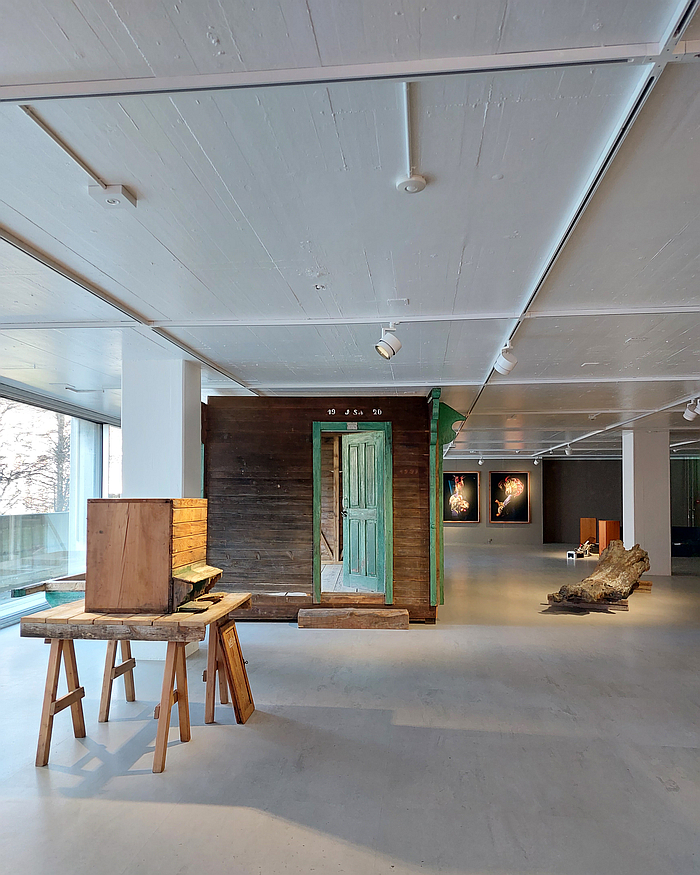
.......or perhaps more accurately, a tricky question Swiss artist Sandra Knecht has been seeking to approach in and via her work for a number of years. An ongoing process, an ongoing personal search, charted in the exhibition, essay, Home Is a Foreign Place at Kulturstiftung Basel H. Geiger, Basel.
An exhibition, essay, in a variety of materials that for all it is a very biographical, personal, exploration... or, again, perhaps more accurately... exactly because it is a very biographical, personal, exploration, is also an invitation to take Knecht's reflections, Knecht's questioning, Knecht's approaches, as stimuli for your own reflections, your own questioning, your own approaches, to and on 'home', material and immaterial.
'Home' material such as the wooden cabin that dominates the main exhibition space, that suggestion, intimation, of a Henry David Thoreau's cabin on the banks of Walden Pond, arguably Thoreau's search for 'home', his 'home' as a foreign place.
Except it has no roof. Whereas with Thoreau's Walden, "the roof was the soundest part, though a good deal warped and made brittle by the sun"2, with Knecht's Walden, the roof is lying, broken, in the room next door. Is anything but "the soundest part". And upon entering that so rugged, solid, construction, you realise that a wall is missing; thus as you sit within the space defined by the roofless three-walls rather than the cocooning safety of a building you have a panoramic view, a portal to the wider world, and a space open to the elements that leaves you exposed and, potentially, trapped. Is the promise of 'home' made by any material structure as deceptive, as disingenuous, as the promise made by Knecht's Walden? Is the promise of 'home' made by any manufacturer and supplier of material goods for use within a material structure as deceptive, as disingenuous, as the promise made by Knecht's Walden?
A Walden once occupied not by a reflective rural recluse, but bees, was a bee-house, a very particular architectural genre, and a reminder that not just humans need a 'home' but animals do as well; a reminder regularly reinforced by the number of photos of animals to be found in Home Is a Foreign Place, animals Sandra Knecht has shared her life with, shared her material spaces with. And animals whose definition of 'home' may or may not be different from ours. But how would we know? And how would our search for 'home' change if we knew how animals define 'home'? What could we learn? Would we learn? Are we too egotistical in our search for 'home', in our demand for 'home'? Do animals do it better? Simpler?

A bee-house that once stood in the village of Hasle near Entlebuch in central Switzerland, that Knecht dismantled, removed, and reassembled out of context; much as the numerous houses at Ballenberg Open Air Museum have been transported from all corners of Switzerland to create a Switzerland that never existed as a component of a collective memory of Switzerland, an invented collective memory of Switzerland conserved.
An act of conservation taken to extremes in Home is a Foreign Place via the section of a tree trunk that lies in front of the out-of-context bee-house. A section of a tree... we'll say oak, or possibly apple, we don't know, but do know that oak and apple are very emotive trees, trees that have a lot to do with 'home' in a European, a Swiss, context... a section of a tree from the village of Buus, near Basel, painstakingly modelled by Knecht and cast in bronze, and thus conserved for all time. An act that finds an echo in the myriad jars and bottles in which Knecht has conserved all manner of Swiss fruit, veg and plants; that way when we believe we've found 'home' we seek to conserve, preserve, it.
But should we conserve it? Is 'home' a memory? Something apparently implied by the aforementioned array of photos, and also by the mummified remains of flora and fauna from Knecht's past carefully archived in boxes, the past carefully conserved as a memory of a 'home' Knecht, one presumes, thought she'd found. And when viewed from today? Was that 'home'? And if it was, is it still 'home' when conserved, inanimate, static, in photos and boxes? Or was it 'home' because it was vital?
And can we conserve it? Over time the mummified remains will crumble to dust, the photos will fade, the fruit, veg and plants will undergo fundamental, irreversible, biological and chemical transformations within their jars, bottles and preserving fluids and the bronze tree will take on a patina. Is patina not part of 'home', is the Gebrauchspatina, Patina of Use, of a Karl Clauss Dietel, that patina of experience, of interaction, of the ups and downs of life, not part of what makes 'home'? Must we not change, must 'home' not change?
Is 'home' a fixed thing? Or is 'home' something that is always in flux?
Is 'home' movement?

Which brings us back to the bees, not just to the portal to the wider world they used to buzz through, but also to the bee-box that stands next to the bee-house, a bee-box the bees vacated, whereby the question of whether it was an enforced or voluntary departure is not irrelevant, but without talking to the bees one it is impossible to approach; and a bee-box into which wasps moved. A change of use, what was once 'home' for one becoming 'home' for something else, the same space with different meanings that not only reminds of the constant movement of life but also causes one to reflect on the value we place on the 'home' physical. How we occupy a space as 'home'.
And an occupying of a convenient empty space that also stands as a reminder that 'home' can be something forced upon us, a space we have to find a way to call 'home'. A reality graphically reinforced by the chapter on orphanages in Fairy Tale. Childhood in Lithuania during the late Soviet era at Kaunas Picture Gallery and also by Natalia Romik. Hideouts. Architecture of Survival at the Jewish Museum, Frankfurt, with its discussions on, and recreations of, the hiding spaces Polish and Ukrainian Jews were forced to call 'home' in the 1930s and 40s by way of avoiding the Nazis who had made their former 'home' a dangerously foreign place.
Hideouts whose need to be closely disguised also finds an echo in the various masks that populate Home Is a Foreign Place and that, for us, stand proxy for that adopting a character, a persona, we all undertake for a variety of reasons and which poses the question why the need for pretence?
Is 'home' about identity?
And if it is, how do identity's develop?
A question that used to be easy to answer, in many regards couldn't have been posed in the relatively simpler society of the past, wasn't a question that concerned the former residents of the houses conserved in Ballenberg, is a question we've formulated and subsequently answered on their behalf from our perspective; but that today with the insistent influences that we continually move within, the demands that we this or that, that we consume this or that, the myriad identities historic and contemporary were expected to simultaneously possess in a volatile global society, the increasing lack of the option to simply to be yourself, to develop, is a question that is almost impossible to answer. A question as hard to answer as the definition of 'home'.
And is that perhaps the search we're all on today? A search for an identity? A search for an identity as a 'home'? For a 'home' that was once an identity we can no longer locate? A desire for an identity, for a shared identity, for our place in a group?
Is 'home' collective?
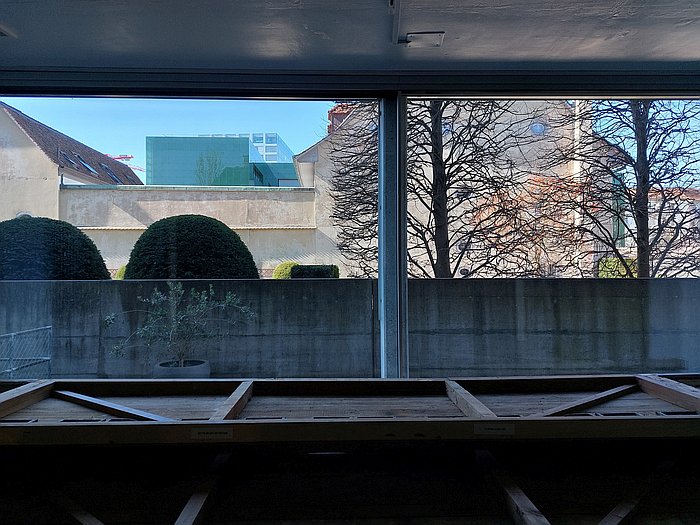
Which brings us back to the question of how animals define 'home'. Brings us back to the question of how the thousands of Polish and Ukrainian Jews managed to make a bunker under a house, or a cave system, a 'home'. Brings us back to conserving a collective past.
And also brings us to a Verner Panton who once asked, "Isn't well-being good music, an agreeable aroma, good food and drink, pleasant company, good entertainment?"3; which one can easily paraphrase as, Isn't 'home' good music, an agreeable aroma, good food and drink, pleasant company, good entertainment?
"Good food and drink, pleasant company" that are notably absent from Home Is a Foreign Place, but as can be gleaned from the accompanying publication are important components of Sandra Knecht's oeuvre, of Sandra Knecht's search for 'home'. "Good music" that is very much present in Home Is a Foreign Place via a selection from Knecht's record collection that visitors are invited to listen to while sat on a large sofa. And also very present in the accompanying publication via a collection of, what we presume to be, track listings for either actual mix tapes Knecht has made, or Knecht's fantasy playlists. Records and track listings for all that numerous themes can be identified within them, and connections made, arguably allow one to approach Sandra Knecht the person as opposed to Sandra Knecht the artist, aren't monosyllabic, rather represent a wide and varied mix of genres, approaches, opinions, worlds, discourses; arguably stand proxy for Knecht's approaching of 'home', are an alternative context in which to observe Knecht's approaching of 'home'.
And in their heterogeneity and willingness to move, ease of movement, appreciations of the necessity of moving, between differing genres, approaches, opinions, worlds, discourses also tend, certainly for us, to support a Henry David Thoreau's opinion that, "we should come home from far, from adventures, and perils, and discoveries every day, with new experiences and character" and not "come tamely home at night only from the next field or street".4 That we should exist outwith our comfort zones, that we should seek, demand, the unknown; and that 'home' is something that changes and evolves with us as we change and evolve through adventures, perils, discoveries, experiences, through becoming familiar with that which was foreign, through making the far near.
Or as Dylan reformulated his question, "How does it feel? To be on your own, with no direction home A complete unknown, like a rolling stone".
"With no direction home".
Yes, one still needs to define "home", but it has ceased to become a definitive, and, arguably, has ceased to be a destination, be that a material or immaterial destination; has become a component of the now flowing endlessly into the future. Has become ephemeral, fugitive. And thus even harder to define.
An argument Home Is a Foreign Place also tends to make, certainly in our reading of Knecht's exhibition, essay, and thereby not only enables more nuanced reflections on 'home', but empowers you to be more honest in your dealings with 'home' as both a concept and that place you are currently in. To be more honest, more open, in your dealings with 'home' material and 'home' immaterial. And admonishes we all learn to embrace the foreign as 'home'.
Sandra Knecht - Home Is a Foreign Place is scheduled to run at Kulturstiftung Basel H. Geiger, Spitalstrasse 18, 4056 Basel until Sunday April 27th.
In addition an accompanying publication is available via Hatje Cantz.
Full details can be found at www.kbhg.ch
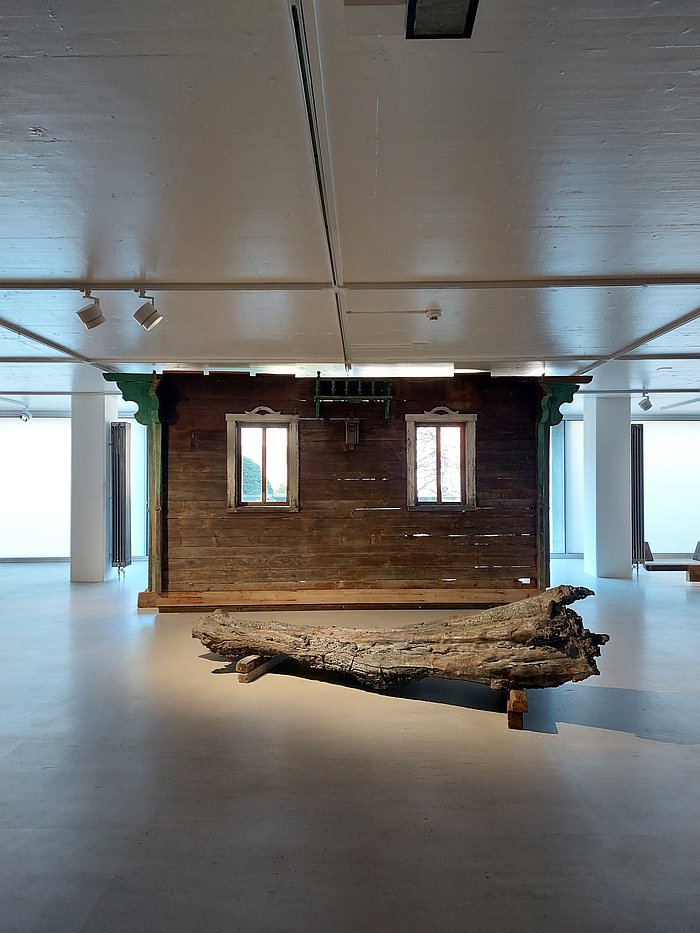
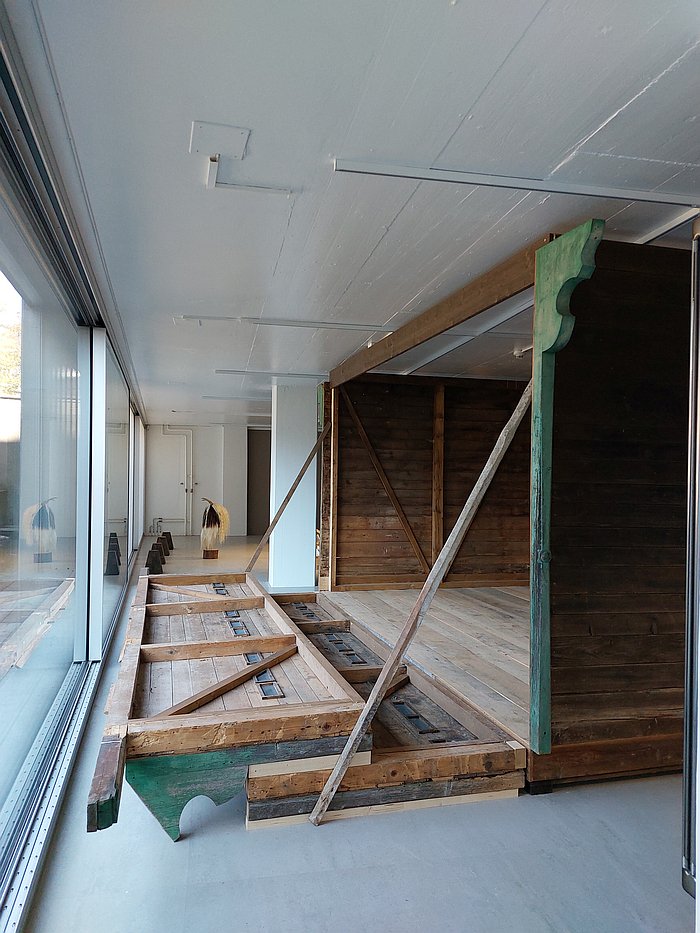
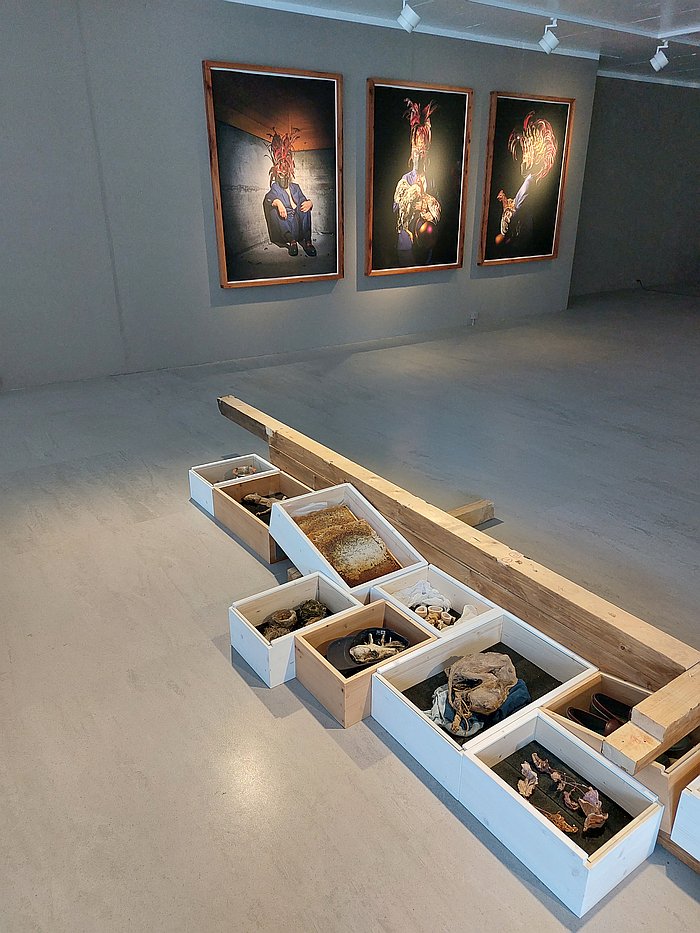
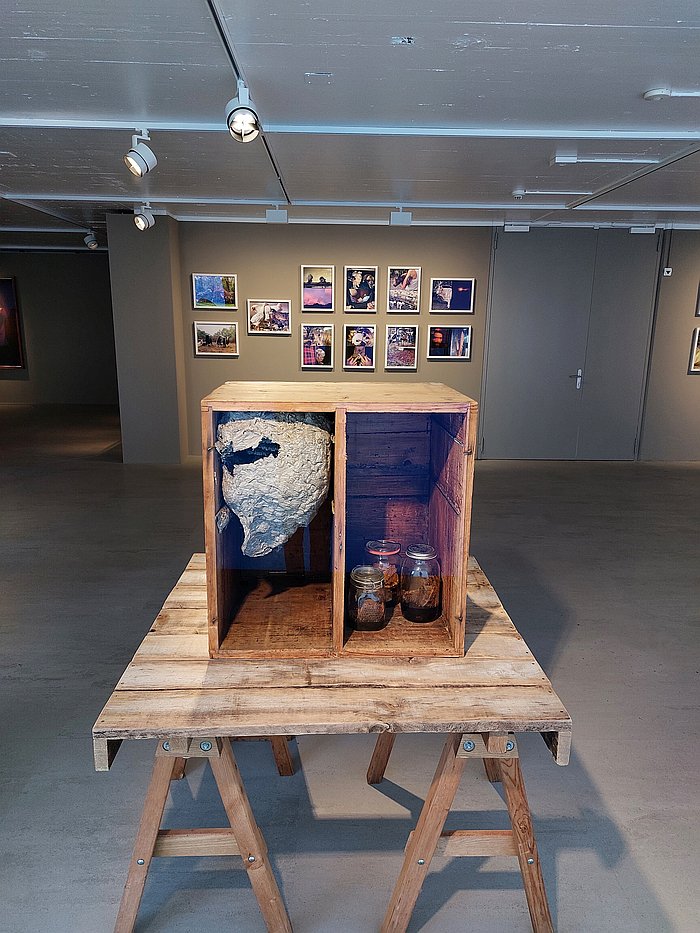
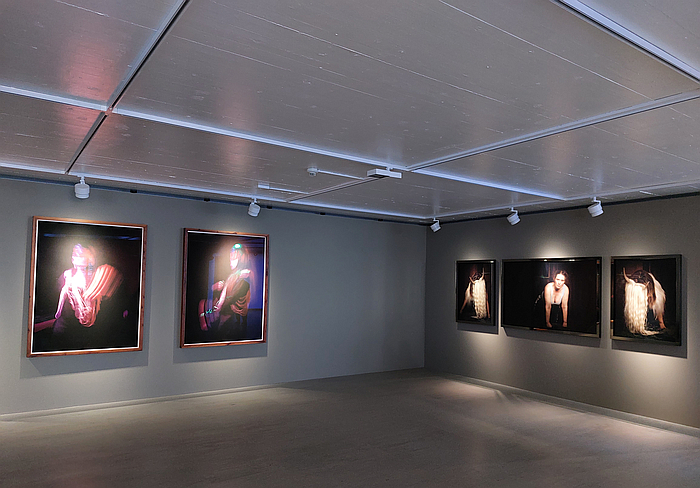
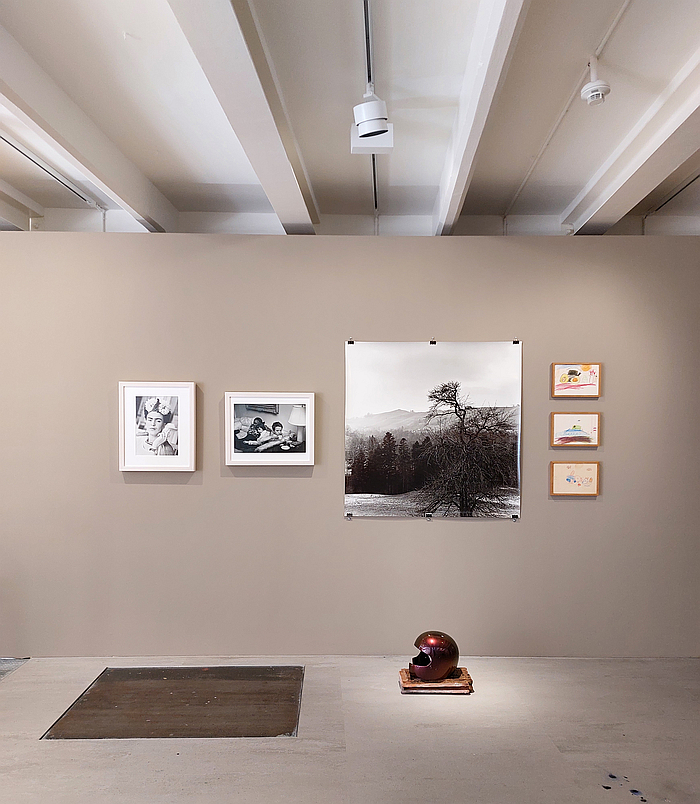

1Bob Dylan, Like a Rolling Stone, on Bob Dylan, Highway 61 Revisited, Columbia Records, 1965, CL 2389
2Henry David Thoreau, Walden; or, Life in the Woods, 1854, here as reprinted in Joseph Wood Krutch [Ed.], Henry David Thoreau, Walden and Other Writings, Bantam Books, 2004 page 144
3Verner Panton: Meine Design-Philosophie, BÜROszene, Vol 47, Nrs. 1–2, 1995
4Henry David Thoreau, Walden; or, Life in the Woods, 1854, here as reprinted in Joseph Wood Krutch [Ed.], Henry David Thoreau, Walden and Other Writings, Bantam Books, 2004 page 272